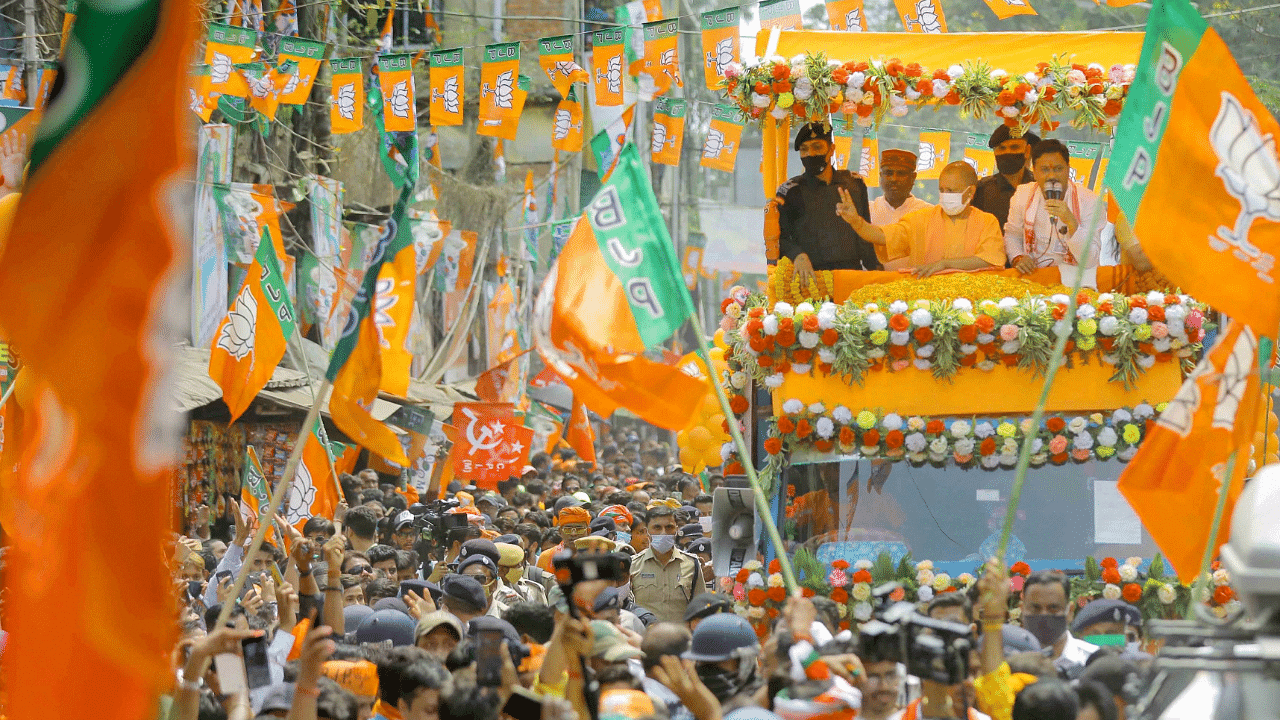
Certain developments on the electoral scene indicate that the Hindutva juggernaut is facing new challenges in its epicentre, Uttar Pradesh. Its future course will depend on how it overcomes them. One of the things coming out in the UP elections is that an increasing number of people are beginning to say that religion is not everything. They need other things, such as social dignity, a job, and cheaper food and fuel. If the drivers of the Hindutva juggernaut cannot provide them those things, they would rather get off that vehicle and get on one that is going in that direction. It shows the impermanence of Hindutva as a political ideology, giving some hope to pluralists.
The BJP has been using UP as a laboratory for testing a ‘Hindutva model’ of government—a model that, in the words of Prime Minister Narendra Modi, combines virasat (heritage) with vikas (development). Yogi Adityanath was seen by the party as the best person to execute the model, so he was made the Chief Minister. And, in the party’s estimation, he has done exceptionally well. In all his speeches, he proudly points to the Ram temple (virasat) and to the expressways and international airports (vikas).
Modi and Yogi have been at pains to prove that their ‘Hindutva model’ of development is far better for social inclusion than the ‘social justice model’ of the Samajwadi Party. Their model, they say, has brought benefits to all castes and communities, unlike the Samajwadi Party government that provided benefits only to a few castes. Social equality and social harmony have been truly established under their rule, they claim. To support their claim, they point to the massive support of the non-Yadav Backward Classes and Dalits their party had amassed in recent years. If you were to believe Modi and Yogi, UP is well on its way to becoming a ‘Ram Rajya’, with a Rambhakt ruling as honestly, justly and non-discriminatingly as Ram, and the people of all classes having absolute trust in his justice and fairness as the subjects of Ram had in his.
That it is not so became clear soon after the elections were announced, when a number of MLAs of the BJP whose political careers depended on the support of non-Yadav Backward Classes resigned from the party. The indication from their resignations was that their constituencies were dissatisfied with the BJP’s performance. And reports from the grassroots corroborated that perception. There was a large gap between the government’s propaganda of what it had given to the lower classes and the realities of the life they were living.
Ground reports spoke of the lower classes in several villages being denied financial assistance under the Pradhan Mantri Awaas Yojana to build pucca houses because they could not afford to pay the bribe the local officials demanded. Such villages included Jayapur, one of the four villages in the Varanasi district adopted by Modi as the MP of the constituency. In villages declared ODF (open defecation free), several poor people still had no toilets. In other villages, the toilets built had become dysfunctional.
Yogi claimed that he had made women’s lives secure, but in the villages, girls from poorer classes going out to work in the fields or tending to cattle still face serious risks of being molested, raped and killed. In 2020, there were 9,864 cases of assaults on women with intent to outrage their modesty in UP, according to the National Crime Records Bureau. The total number of crimes reported against women in the state were 59,445 in 2018, 59,853 in 2019 and 49,385 in 2020, the highest among all states.
In every case of injustice against the lower classes, the perpetrators of the injustice happened to be from the better-off classes. The pradhans (panchayat heads) who demanded 20% cut from the financial assistance under the PM Awaas Yojana, the men who molested and raped girls in villages, and the policemen who acted on the side of the perpetrators, were all from the better-off classes. The poorer classes of UP had always seen themselves as chhote log (small people) oppressed and exploited by bade log (big people). That has not changed under Yogi’s rule. That is why there is disappointment with the BJP among the lower classes.
What has added to their disappointment is the opposition of the BJP to a socio-economic caste census. The poorer communities among the Backward Classes have come to the conclusion that unless a caste census is done, the benefits of public sector jobs and college admissions will never be distributed equitably. The Yogi government has even refused to implement the recommendation of its own Social Justice Committee for the division of 27% reservations for OBCs into three categories of Backward Class (7%), More Backward Class (11%) and Most Backward Class (9%).
The discontent among the lower castes has busted the self-illusion of the BJP that it can bind all castes securely with the Hindutva glue. The lower castes want security, dignity and upward mobility and are not going to give up those concerns for the sake of Hindu unity. Hindu unity to them has proven to be a chimera which only perpetuates deep social and economic divisions.
Today, Hindutva lies wounded in the ruins of the social coalition the BJP built. The big lesson for the party is: It has to address the fundamental issues of social inequality, social injustice, economic oppression and administrative discrimination and corruption the chhote log face in their lives before it can hope to bind all castes with the Hindu glue. But as the bade log make up the core constituency of the BJP, it is the last thing the party is tempted to do. And that is sure to leave it in a state of dilemma. We will see how it resolves its dilemma in the coming years.
(The writer is an independent journalist and author)